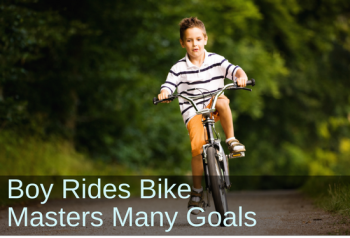Boy Rides Bike, Masters Many Goals
Submitted by Angela Bowman

|
Before
|
After
|
|
Challenges navigating changes in routine
|
Tremendous progress working through changes in routine
|
|
Unable to ride a bike
|
Can now ride a bike
|
|
Delayed motor skills; avoided crossing the midline
|
Much less avoidance of crossing midline; now uses his right hand as a dominant and stabilizes with his left hand
|
|
Often experienced tantrums
|
Few tantrums
|
|
Usually played by himself
|
Beginning to make friends
|
|
Scored 5% for grasp and 37% for visual motor integration on the Peabody Developmental Scales
|
Scored average or above average on the Bruininks Oseretsky (has aged out of the Peabody)
|
Kevin is a 5-year-old boy who was brought to the occupational therapy clinic where I work by his mother in August 2017 for an evaluation.
"Kevin's mother was concerned about his delayed motor skills, including his inability to ride a bicycle, difficulty with zipping his jacket, tying his shoes, writing his name, and peeling a sticker from a sticker sheet, as well as reports that he appears 'slow to learn.' Kevin's mother stated that he sometimes paces and has tantrums, and that he tends to play by himself more often than with other kids."
His SLP and PCP have suggested Kevin be tested for autism, however he has not yet been tested. The evaluation showed that he was below average in his visual motor skills (poor range using standardized testing). As far as his sensory systems, he demonstrated some sensory processing differences, specifically, poor body awareness, avoidance of crossing mid-line, sensory modulation challenges, sensory hypersensitivities and gravitational insecurity. He therefore seeks out more sensory input through his muscles and joints in the form of jumping and pacing around the classroom and at home, but then is sensitive to other types of input such as noise, movement and bright lights.
His gravitational insecurity and poor body awareness result in poor motor planning, which is necessary for high-level coordination tasks of shoelace tying, bike riding and handwriting -- areas of concern to his mother. His social/play skills were impacted by these deficits resulting in frequent solo play and intermittent meltdowns at home that are very difficult to recover from.
Kevin began therapy using a sensory integrative approach for a month before his reflex integration skills were tested. Kevin had made some progress before but remained weak in the above mentioned areas and was having more meltdowns at home and school.
I noticed within two to three weeks [of applying the movements from the Brain and Sensory Foundations course] he was no longer requiring physical facilitation with cross crawls and hook ups. These activities were initially very difficult for Kevin but he made gains weekly and improved his coordination and efficiency. We also performed various rhythmic movements each session and mom carried out at home. One in particular that he responded well to was RM #1 Passive Stimulation from the Knees in Supine Position. I would sing “Hickory Dickory Dock” as in the video and he named it Hickory Dickory Dock and began to ask for it most sessions.
As his motor skills started progressing, I really want to work on the social/emotional component and I knew that meant working on the Fear Paralysis and the Moro reflex. One of the big emotional challenges for Kevin was dealing with changes in his routine and we decided to make this his goal in the 5-step balance process.
"He has made tremendous progress with his ability to work through changes in his routine now and his teacher has even noticed the changes at school. Kevin participated in these activities over a period of 9 weeks. He has now mastered many of his goals and is now able to ride a bike!! He can (almost) tie his shoes and has much less avoidance of crossing mid line and is using his right hand as a dominant and stabilizing with his left hand. His visual motor skills are now in the average range. Mom reports less tantrums at home and he is beginning to make friends."
I have learned a lot by working with Kevin and utilizing the information from the Brain and Sensory Foundations course. Often I see children with these poor motor planning skills and they do not cross mid-line or separate the two sides of their bodies and now I see that often they have unintegrated reflexes. When I go back and work on the reflexes, the motor skills get better and then they can motor plan better for new situations because they are not “stuck” in these reflex patterns.
I now have a great tool in helping children with some of their emotional issues by using the 5-step balancing process. Most of the children I work with are struggling emotionally and we cannot work on the motor skills and ignore this but before this program there were not a lot of modalities that I possessed to help these kids. I found that with parent support, Kevin made so many gains in his emotional stability and the mom has stated that she will continue to use these strategies with him for life.
Note: The initial evaluation the Peabody Developmental Scales were used and he was 5% which is in the poor range for grasp and 37% which is average for visual motor integration. When re-assessed he had aged out of the Peabody so the Bruininks Oseretsky was used and all areas were in the average or above average range.
(Emphasis added; edited for brevity)
Case Study by Angela Bowman


